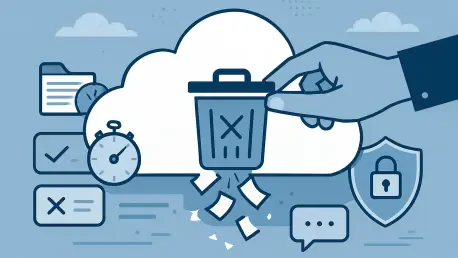In an era where digital life hinges on cloud storage, the policies of tech giants like Google and Apple regarding data deletion for unpaid subscriptions have become a pressing concern for millions of users worldwide. Every day, countless individuals and businesses entrust their photos, documents, and critical data to services like Google One and Apple iCloud, often without fully grasping what happens if a payment is missed. The fine print of these policies can mean the difference between retaining cherished memories or losing them forever, making it vital to understand the specifics. This article peels back the layers of complexity surrounding these deletion practices, exploring the grace periods offered, the risks users face, and the broader implications of relying on subscription-based cloud storage. By examining the approaches of two of the biggest players in the industry, a clearer picture emerges of how to navigate the potential pitfalls and protect valuable digital assets from unexpected erasure.
Timelines for Data Retention and Deletion
The policies governing unpaid subscriptions at Google and Apple reveal stark differences in how each company handles data retention, offering varying degrees of leniency for users who fall behind on payments. Google One, for instance, provides a two-month grace period following a missed payment, during which access to stored files remains possible, though uploading new content is restricted. Should the account remain inactive beyond this window, Google reserves the right to permanently delete the data, but not without issuing multiple warnings via email or notifications to prompt users into action. This approach seems designed to balance user convenience with the practical need to manage server space, ensuring that accidental data loss is minimized through proactive communication. However, the onus still falls on users to heed these alerts and resolve payment issues promptly to avoid irreversible consequences that could impact both personal and professional spheres.
In contrast, Apple’s iCloud operates on a tighter schedule, granting only a 30-day window after a subscription cancellation before stored content faces deletion. This shorter timeframe means users must act swiftly to reinstate their subscription or download critical files to alternative storage solutions. Unlike Google’s extended buffer, Apple’s policy underscores a more immediate response to non-payment, potentially catching some users off guard if they’re unaware of the deadline. The disparity in these timelines highlights a fundamental difference in philosophy—while Google offers more breathing room to recover, Apple prioritizes efficiency in clearing inactive accounts. For users juggling multiple subscriptions or facing financial constraints, understanding these distinct periods is crucial to prevent the loss of irreplaceable data and to plan contingencies accordingly.
Regulatory Pressures and User Vulnerabilities
Cloud storage policies are not shaped solely by corporate decisions; regulatory frameworks exert significant influence, particularly for businesses bound by strict compliance standards. Laws like HIPAA, which governs healthcare data in the United States, mandate specific retention periods for certain records, often extending years beyond what standard cloud deletion policies might allow. For providers like Google and Apple, this creates a delicate balancing act—adhering to privacy regulations that demand the deletion of data from inactive accounts to prevent unauthorized access, while also accommodating industries with prolonged retention needs. Failure to navigate this complexity can result in legal repercussions or breaches of trust, pushing companies to offer customizable solutions for enterprise clients while maintaining stricter defaults for individual users.
For everyday users, the risks tied to unpaid subscriptions are more personal but no less severe, as the potential loss of data can strike at the heart of digital life. Online discussions frequently reveal frustration over the perception that data is “held hostage” by subscription models, with many feeling trapped by recurring fees they struggle to maintain during economic hardship. A missed payment could erase family photos, work documents, or other irreplaceable files, amplifying stress and highlighting the vulnerability of relying solely on cloud storage. While Google and Apple provide grace periods as a buffer, these are not foolproof, and oversight or delayed notifications can lead to permanent deletion. This reality underscores the urgency for users to stay informed about policy details and remain vigilant about account status to safeguard against such devastating outcomes.
Rising Subscription Fatigue and New Solutions
A noticeable undercurrent of dissatisfaction, often termed subscription fatigue, is reshaping how users view traditional cloud storage services offered by giants like Google and Apple. The constant pressure of recurring payments, coupled with the looming threat of data deletion for non-payment, has driven many to seek alternatives that prioritize flexibility and security. Social media platforms buzz with complaints about the financial burden of multiple subscriptions, prompting a shift in mindset toward solutions that eliminate the risk of losing data due to a missed bill. This growing discontent signals a broader demand for models that empower users rather than tether them to endless payment cycles, challenging the dominance of conventional cloud providers.
Emerging alternatives are gaining traction as viable options for those disillusioned with subscription-based systems, offering fresh approaches to data storage without the associated anxiety. Lifetime storage plans, such as those provided by companies like Internxt, allow users to pay once for significant storage capacity, removing the specter of recurring fees and deletion threats. Additionally, decentralized storage networks leveraging blockchain technology present a cutting-edge solution, distributing data across multiple nodes to enhance security and eliminate dependency on a single provider’s policies. These innovations reflect a pivot toward user-centric design in the storage industry, suggesting that the future may hold more personalized and sustainable ways to manage digital assets, free from the constraints imposed by traditional models.
Empowering Users Through Proactive Measures
Even with grace periods in place, industry experts emphasize that these safeguards are not a complete shield against data loss, urging users to take control of their digital security. Google and Apple may send alerts and provide time to reactivate accounts, but economic challenges, forgetfulness, or technical glitches can result in missed opportunities to save critical files. The consensus is that relying solely on cloud storage without a backup plan is a gamble, as deletion policies are ultimately enforced to manage server costs for inactive accounts. This reality places the responsibility squarely on users to adopt proactive strategies that ensure their data remains safe, regardless of payment status or provider policies.
Building a robust defense against potential data loss involves integrating backup solutions that complement cloud storage, a step deemed essential in today’s digital landscape. Setting up automatic backups to local drives or secondary cloud services can provide a critical safety net, preserving files even if a subscription lapses. Additionally, users should familiarize themselves with the specific deletion timelines and notification processes of their chosen providers to avoid being caught off guard. As cloud dependency continues to grow, cultivating these habits transforms from a mere precaution into a fundamental aspect of managing a digital presence. Empowering users with knowledge and tools to protect their information is the key to navigating the uncertainties of subscription-based storage systems effectively.









